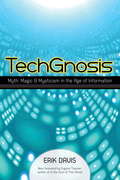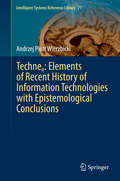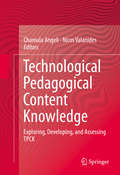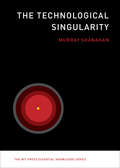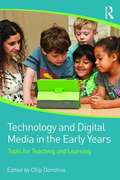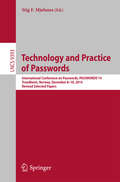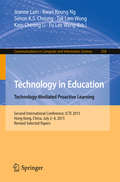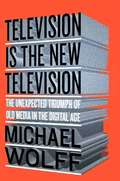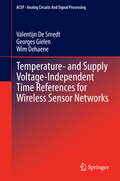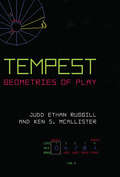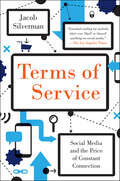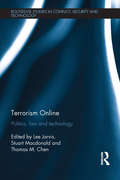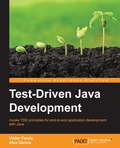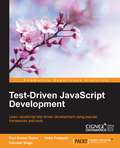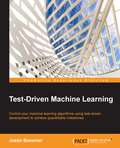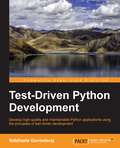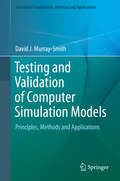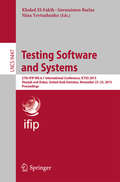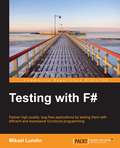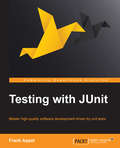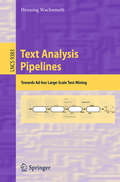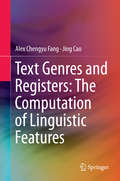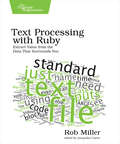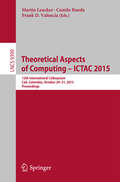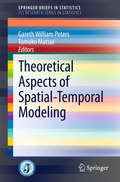- Table View
- List View
TechGnosis
by Eugene Thacker Erik DavisHow does our fascination with technology intersect with the religious imagination? In TechGnosis--a cult classic now updated and reissued with a new afterword--Erik Davis argues that while the realms of the digital and the spiritual may seem worlds apart, esoteric and religious impulses have in fact always permeated (and sometimes inspired) technological communication. Davis uncovers startling connections between such seemingly disparate topics as electricity and alchemy; online roleplaying games and religious and occult practices; virtual reality and gnostic mythology; programming languages and Kabbalah. The final chapters address the apocalyptic dreams that haunt technology, providing vital historical context as well as new ways to think about a future defined by the mutant intermingling of mind and machine, nightmare and fantasy.From the Trade Paperback edition.ology; programming languages and channeled texts. The final chapters address both apocalyptic and utopian dreams of the future of technology, providing historical context as well as new models for how to think and feel our way through an amazing, confusing, and disturbing time. This new edition features a foreword by Eugene Thacker as well as a new afterword reflecting on surveillance; the current tech bubble; the growth of superheroes, horror, and other "uncanny cultures" online; the growing backlash against technology; and the need to revitalize the cosmic imagination.ContentsIntroduction: crossed wires I imagining technologies II the alchemical fire III the gnostic infonaut IV techgnosis, american-style V the spiritual cyborg VI a most enchanting machine VII cyberspace: the virtual craft VIII the alien call IX datapocalypse X third mind from the sun XI the path is a network Afterword: beyond the boomFrom the Trade Paperback edition.
Technen: Elements of Recent History of Information Technologies with Epistemological Conclusions
by Andrzej Piotr WierzbickiThe book expresses the conviction that the art of creating tools - Greek techne - changes its character together with the change of civilization epochs and co-determines such changes. This does not mean that tools typical for a civilization epoch determine it completely, but they change our way of perceiving and interpreting the world. There might have been many such epochs in the history of human civilization (much more than the three waves of agricultural, industrial and information civilization). This is expressed by the title Technen of the book, where n denotes a subsequent civilization epoch. During last fifty years we observed a decomposition of the old episteme (understood as a way of creating and interpreting knowledge characteristic for a given civilization epoch) of modernism, which was an episteme typical for industrial civilization. Today, the world is differently understood by the representatives of three different cultural spheres: of strict and natural sciences; of human and social sciences (especially by their part inclined towards postmodernism) and technical sciences that have a different episteme than even that of strict and natural sciences. Thus, we observe today not two cultures, but three different episteme. The book consists of four parts. First contains basic epistemological observations, second is devoted to selected elements of recent history of information technologies, third contains more detailed epistemological and general discussions, fourth specifies conclusions. The book is written from the cognitive perspective of technical sciences, with a full awareness - and discussion - of its differences from the cognitive perspective of strict sciences or human and social sciences. The main thesis of the book is that informational revolution will probably lead to a formation of a new episteme. The book includes discussions of many issues related to such general perspective, such as what is technology proper; what is intuition from a perspective of technology and of evolutionary naturalism; what are the reasons for and how large are the delays between a fundamental invention and its broad social utilization; what is the fundamental logical error (using paradoxes that are not real, only apparent) of the tradition of sceptical philosophy; what are rational foundations and examples of emergence of order out of chaos; whether civilization development based on two positive feedbacks between science, technology and the market might lead inevitably to a self-destruction of human civilization; etc.
Technological Pedagogical Content Knowledge
by Charoula Angeli Nicos ValanidesTechnological pedagogical content knowledge (TPCK) reflects a new direction in understanding the complex interactions among content, pedagogy, learners and technology that can result in successful integration of multiple technologies in teaching and learning. The purpose of this edited volume is to introduce TPCK as a conceptual framework for grounding research in the area of teachers' cognitive understanding of the interactions of technology with content, pedagogy and learner conceptions. Accordingly, the contributions will constitute systematic research efforts that use TPCK to develop lines of educational technology research exemplifying current theoretical conceptions of TPCK and methodological and pedagogical approaches of how to develop and assess TPCK.
The Technological Singularity (The MIT Press Essential Knowledge series)
by Murray ShanahanThe idea of technological singularity, and what it would mean if ordinary human intelligence were enhanced or overtaken by artificial intelligence.The idea that human history is approaching a “singularity”—that ordinary humans will someday be overtaken by artificially intelligent machines or cognitively enhanced biological intelligence, or both—has moved from the realm of science fiction to serious debate. Some singularity theorists predict that if the field of artificial intelligence (AI) continues to develop at its current dizzying rate, the singularity could come about in the middle of the present century. Murray Shanahan offers an introduction to the idea of the singularity and considers the ramifications of such a potentially seismic event.Shanahan's aim is not to make predictions but rather to investigate a range of scenarios. Whether we believe that singularity is near or far, likely or impossible, apocalypse or utopia, the very idea raises crucial philosophical and pragmatic questions, forcing us to think seriously about what we want as a species. Shanahan describes technological advances in AI, both biologically inspired and engineered from scratch. Once human-level AI—theoretically possible, but difficult to accomplish—has been achieved, he explains, the transition to superintelligent AI could be very rapid. Shanahan considers what the existence of superintelligent machines could mean for such matters as personhood, responsibility, rights, and identity. Some superhuman AI agents might be created to benefit humankind; some might go rogue. (Is Siri the template, or HAL?) The singularity presents both an existential threat to humanity and an existential opportunity for humanity to transcend its limitations. Shanahan makes it clear that we need to imagine both possibilities if we want to bring about the better outcome.
Technology and Digital Media in the Early Years: Tools for Teaching and Learning
by Chip DonohueThis book provides strategies, theoretical frameworks, links to research evidence, descriptions of best practice, and resources to develop essential digital literacy knowledge, skills, and experiences for early childhood educators in the digital age.
Technology and Practice of Passwords
by Stig F. MjølsnesThis book constitutes the thoroughly refereed post-conference proceedings of the 7th International Conference on Passwords, PASSWORDS 2014, held in Trondheim, Norway, in December 2014. The 8 revised full papers presented together with 2 revised short papers were carefully reviewed and selected from 30 initial submissions. The papers are organized in topical sections on hash functions, usability, analyses and new techniques.
Technology in Education. Technology-Mediated Proactive Learning
by Jeanne Lam Kwan Keung Ng Simon K.S. Cheung Tak Lam Wong Kam Cheong Li Fu Lee WangThis bookconstitutes extended papers from the Second International Conference onTechnology in Education, ICTE 2015, held in Hong Kong, China, in July 2015. The 26 fullpapers presented in this volume were carefully reviewed and selected from 41submissions. They were organized in topical sections named: technology-enabledlearning; mobile learning and ubiquitous learning; open learning and onlinelearning; institutional strategies, policies and practices; and learningplatforms and advising systems.
Television Is the New Television
by Michael Wolff"The closer the new media future gets, the further victory appears." --Michael WolffThis is a book about what happens when the smartest people in the room decide something is inevitable, and yet it doesn't come to pass. What happens when omens have been misread, tea leaves misinterpreted, gurus embarrassed?Twenty years after the Netscape IPO, ten years after the birth of YouTube, and five years after the first iPad, the Internet has still not destroyed the giants of old media. CBS, News Corp, Disney, Comcast, Time Warner, and their peers are still alive, kicking, and making big bucks. The New York Times still earns far more from print ads than from digital ads. Super Bowl commercials are more valuable than ever. Banner ad space on Yahoo can be bought for a relative pittance.Sure, the darlings of new media--Buzzfeed, HuffPo, Politico, and many more--keep attracting ever more traffic, in some cases truly phenomenal traffic. But as Michael Wolff shows in this fascinating and sure-to-be-controversial book, their buzz and venture financing rounds are based on assumptions that were wrong from the start, and become more wrong with each passing year. The consequences of this folly are far reaching for anyone who cares about good journalism, enjoys bingeing on Netflix, works with advertising, or plans to have a role in the future of the Internet.Wolff set out to write an honest guide to the changing media landscape, based on a clear-eyed evaluation of who really makes money and how. His conclusion: the Web, social media, and various mobile platforms are not the new television. Television is the new television.We all know that Google and Facebook are thriving by selling online ads--but they're aggregators, not content creators. As major brands conclude that banner ads next to text basically don't work, the value of digital traffic to content-driven sites has plummeted, while the value of a television audience continues to rise. Even if millions now watch television on their phones via their Netflix, Hulu, and HBO GO apps, that doesn't change the balance of power. Television by any other name is the game everybody is trying to win--including outlets like The Wall Street Journal that never used to play the game at all.Drawing on his unparalleled sources in corner offices from Rockefeller Center to Beverly Hills, Wolff tells us what's really going on, which emperors have no clothes, and which supposed geniuses are due for a major fall. Whether he riles you or makes you cheer, his book will change how you think about media, technology, and the way we live now.From the Hardcover edition.
Temperature- and Supply Voltage-Independent Time References for Wireless Sensor Networks
by Valentijn De Smedt Georges Gielen Wim DehaeneThis book investigates the possible circuit solutions to overcome the temperature and supply voltage-sensitivity of fully-integrated time references for ultra-low-power communication in wireless sensor networks. The authors provide an elaborate theoretical introduction and literature study to enable full understanding of the design challenges and shortcomings of current oscillator implementations. Furthermore, a closer look to the short-term as well as the long-term frequency stability of integrated oscillators is taken. Next, a design strategy is developed and applied to 5 different oscillator topologies and 1 sensor interface. All 6 implementations are subject to an elaborate study of frequency stability, phase noise and power consumption. In the final chapter all blocks are compared to the state of the art.
Tempest: Geometries Of Play
by Judd Ethan Ruggill Ken S. McallisterAtari's 1981 arcade hit Tempest was a "tube shooter" built around glowing, vector-based geometric shapes. Among its many important contributions to both game and cultural history, Tempest was one of the first commercial titles to allow players to choose the game's initial play difficulty (a system Atari dubbed "SkillStep"), a feature that has since became standard for games of all types. Tempest was also one of the most aesthetically impactful games of the twentieth century, lending its crisp, vector aesthetic to many subsequent movies, television shows, and video games. In this book, Ruggill and McAllister enumerate and analyze Tempest's landmark qualities, exploring the game's aesthetics, development context, and connections to and impact on video game history and culture. By describing the game in technical, historical, and ludic detail, they unpack the game's latent and manifest audio-visual iconography and the ideological meanings this iconography evokes.
Terms of Service: Social Media and the Price of Constant Connection
by Jacob SilvermanSocial networking has grown into a staple of modern society, but its continued evolution is becoming increasingly detrimental to our lives. Shifts in communication and privacy are affecting us more than we realize or understand. Terms of Service crystalizes this current moment in technology and contemplates its implications: the identity-validating pleasures and perils of online visibility; our newly adopted view of daily life through the lens of what is share-worthy; and the surveillance state operated by social media platforms—Facebook, Google, Twitter, and others—to mine our personal data for advertising revenue, an invasion of our lives that is as pervasive as government spying.Jacob Silverman calls for social media users to take back ownership of their digital selves from the Silicon Valley corporations who claim to know what's best for them. Integrating politics, sociology, national security, pop culture, and technology, he reveals the surprising conformity at the heart of Internet culture—explaining how social media companies engineer their products to encourage shallow engagement and discourage dissent. Reflecting on the collapsed barriers between our private and public lives, Silverman brings into focus the inner conflict we feel when deciding what to share and what to "like," and explains how we can take the steps we need to free ourselves from its grip.
Terrorism Online: Politics, Law and Technology (Routledge Studies in Conflict, Security and Technology)
by Lee Jarvis Stuart MacDonald Thomas M. ChenThis book investigates the intersection of terrorism, digital technologies and cyberspace. The evolving field of cyber-terrorism research is dominated by single-perspective, technological, political, or sociological texts. In contrast, Terrorism Online uses a multi-disciplinary framework to provide a broader introduction to debates and developments that have largely been conducted in isolation. Drawing together key academics from a range of disciplinary fields, including Computer Science, Engineering, Social Psychology, International Relations, Law and Politics, the volume focuses on three broad themes: 1) how – and why – do terrorists engage with the Internet, digital technologies and cyberspace?; 2) what threat do these various activities pose, and to whom?; 3) how might these activities be prevented, deterred or addressed? Exploring these themes, the book engages with a range of contemporary case studies and different forms of terrorism: from lone-actor terrorists and protest activities associated with ‘hacktivist’ groups to state-based terrorism. Through the book’s engagement with questions of law, politics, technology and beyond, the volume offers a holistic approach to cyberterrorism which provides a unique and invaluable contribution to this subject matter. This book will be of great interest to students of cybersecurity, security studies, terrorism and International Relations.
Test-Driven Java Development
by Alex Garcia Viktor FarcicInvoke TDD principles for end-to-end application development with Java About This Book * Explore the most popular TDD tools and frameworks and become more proficient in building applications * Create applications with better code design, fewer bugs, and higher test coverage, enabling you to get them to market quickly * Implement test-driven programming methods into your development workflows Who This Book Is For If you're an experienced Java developer and want to implement more effective methods of programming systems and applications, then this book is for you. What You Will Learn * Explore the tools and frameworks required for effective TDD development * Perform the Red-Green-Refactor process efficiently, the pillar around which all other TDD procedures are based * Master effective unit testing in isolation from the rest of your code * Design simple and easily maintainable codes by implementing different techniques * Use mocking frameworks and techniques to easily write and quickly execute tests * Develop an application to implement behaviour-driven development in conjunction with unit testing * Enable and disable features using Feature Toggles In Detail Test-driven development (TDD) is a development approach that relies on a test-first procedure that emphasises writing a test before writing the necessary code, and then refactoring the code to optimize it. The value of performing TDD with Java, one of the most established programming languages, is to improve the productivity of programmers, the maintainability and performance of code, and develop a deeper understanding of the language and how to employ it effectively. Starting with the basics of TDD and reasons why its adoption is beneficial, this book will take you from the first steps of TDD with Java until you are confident enough to embrace the practice in your day-to-day routine. You'll be guided through setting up tools, frameworks, and the environment you need, and will dive right in to hands-on exercises with the goal of mastering one practice, tool, or framework at a time. You'll learn about the Red-Green-Refactor procedure, how to write unit tests, and how to use them as executable documentation. With this book you'll also discover how to design simple and easily maintainable code, work with mocks, utilise behaviour-driven development, refactor old legacy code, and release a half-finished feature to production with feature toggles. You will finish this book with a deep understanding of the test-driven development methodology and the confidence to apply it to application programming with Java. Style and approach An easy-to-follow, hands-on guide to building applications through effective coding practices. This book covers practical examples by introducing different problems, each one designed as a learning exercise to help you understand each aspect of TDD.
Test-Driven JavaScript Development
by Hetal Prajapati Ravi Kumar Gupta Harmeet SinghLearn JavaScript test-driven development using popular frameworks and tools About This Book * Learn the life cycle of TDD and its importance in real-world application * Gain knowledge about popular tools and analyze features, syntax, and how they help in JavaScript testing * Implement test-driven programming exercises using the practical code examples Who This Book Is For If you have an intermediate knowledge of HTML, CSS, and JavaScript and want to learn how and why the test-driven development approach is better for your assignments, then this book is for you. What You Will Learn * Basic TDD fundamentals, life cycle, and benefits * Become acquainted with the concepts and elements of unit testing and writing basic unit tests for JavaScript * Understand the way JsUnit, Qunit, Karma and DalekJs work * Use the Jasmine framework * Interpret feature detection and devise tests specific to cross-browser compatibility * Integrate jsTestDriver with Eclipse and run tests with jsTestDriver * Explore re-factoring, adding and notifying observers * Understand test-driven development in case of server-side JS In Detail Initially, all processing used to happen on the server-side and simple output was the response to web browsers. Nowadays, there are so many JavaScript frameworks and libraries created that help readers to create charts, animations, simulations, and so on. By the time a project finishes or reaches a stable state, so much JavaScript code has already been written that changing and maintaining it further is tedious. Here comes the importance of automated testing and more specifically, developing all that code in a test-driven environment. Test-driven development is a methodology that makes testing the central part of the design process - before writing code developers decide upon the conditions that code must meet to pass a test. The end goal is to help the readers understand the importance and process of using TDD as a part of development. This book starts with the details about test-driven development, its importance, need, and benefits. Later the book introduces popular tools and frameworks like YUI, Karma, QUnit, DalekJS, JsUnit and goes on to utilize Jasmine, Mocha, Karma for advanced concepts like feature detection, server-side testing, and patterns. We are going to understand, write, and run tests, and further debug our programs. The book concludes with best practices in JavaScript testing. By the end of the book, the readers will know why they should test, how to do it most efficiently, and will have a number of versatile tests (and methods for devising new tests) to get to work immediately. Style and approach Easy-to-follow guide with suitable examples for developing JavaScript code in the test-Driven environment, with popular tools and frameworks. User experience and statements are also included to help readers make a better choice of tool for real-world projects.
Test-Driven Machine Learning
by Justin BozonierThis book is intended for data technologists (scientists, analysts, or developers) with previous machine learning experience who are also comfortable reading code in Python. You may be starting, or have already started, a machine learning project at work and are looking for a way to deliver results quickly to enable rapid iteration and improvement. Those looking for examples of how to isolate issues in models and improve them will find ideas in this book to move forward.
Test-Driven Python Development
by Siddharta GovindarajThis book is intended for Python developers who want to use the principles of test-driven development (TDD) to create efficient and robust applications. In order to get the best out of this book, you should have development experience with Python.
Testing and Validation of Computer Simulation Models
by David J. Murray-SmithThis must-read text/reference provides a practical guide to processes involved in the development and application of dynamic simulation models, covering a wide range of issues relating to testing, verification and validation. Illustrative example problems in continuous system simulation are presented throughout the book, supported by extended case studies from a number of interdisciplinary applications. Topics and features: provides an emphasis on practical issues of model quality and validation, along with questions concerning the management of simulation models, the use of model libraries, and generic models; contains numerous step-by-step examples; presents detailed case studies, often with accompanying datasets; includes discussion of hybrid models, which involve a combination of continuous system and discrete-event descriptions; examines experimental modeling approaches that involve system identification and parameter estimation; offers supplementary material at an associated website.
Testing Software and Systems
by Khaled El-Fakih Gerassimos Barlas Nina YevtushenkoThis book constitutes the refereed proceedings of the 27th IFIP WG 6. 1 International Conference on Testing Software and Systems, ICTSS 2015, held in Sharjah and Dubai, United Arab Emirates, in November 2015. The 14 revised full papers and 4 short papers presented were carefully reviewed and selected from 42 submissions. The papers are organized in topical sections on model based testing, test derivation methods, monitoring and fault localization, model and system testing, and real-time systems.
Testing with F#
by Mikael LundinIf you are a developer who wants to test applications using F#, this is the book for you. Basic experience of testing and intermediate experience of functional programming in F# is expected.
Testing with JUnit
by Frank AppelMaster high quality software development driven by unit tests About This Book * Design and implement robust system components by means of the de facto unit testing standard in Java * Reduce defect rate and maintenance effort, plus simultaneously increase code quality and development pace * Follow a step-by-step tutorial imparting the essential techniques based on real-world scenarios and code walkthroughs Who This Book Is For No matter what your specific background as a Java developer, whether you're simply interested in building up a safety net to reduce regressions of your desktop application or in improving your server-side reliability based on robust and reusable components, unit testing is the way to go. This book provides you with a comprehensive but concise entrance advancing your knowledge step-wise to a professional level. What You Will Learn * Organize your test infrastructure and resources reasonably * Understand and write well structured tests * Decompose your requirements into small and independently testable units * Increase your testing efficiency with on-the-fly generated stand-in components and deal with the particularities of exceptional flow * Employ runners to adjust to specific test demands * Use rules to increase testing safety and reduce boilerplate * Use third party supplements to improve the expressiveness of your verification statements In Detail JUnit has matured to become the most important tool when it comes to automated developer tests in Java. Supported by all IDEs and build systems, it empowers programmers to deliver software features reliably and efficiently. However, writing good unit tests is a skill that needs to be learned; otherwise it's all too easy to end up in gridlocked development due to messed up production and testing code. Acquiring the best practices for unit testing will help you to prevent such problems and lead your projects to success with respect to quality and costs. This book explains JUnit concepts and best practices applied to the test first approach, a foundation for high quality Java components delivered in time and budget. From the beginning you'll be guided continuously through a practically relevant example and pick up background knowledge and development techniques step by step. Starting with the basics of tests organization you'll soon comprehend the necessity of well structured tests and delve into the relationship of requirement decomposition and the many-faceted world of test double usage. In conjunction with third-party tools you'll be trained in writing your tests efficiently, adapt your test case environment to particular demands and increase the expressiveness of your verification statements. Finally, you'll experience continuous integration as the perfect complement to support short feedback cycles and quality related reports for your whole team. The tutorial gives a profound entry point in the essentials of unit testing with JUnit and prepares you for test-related daily work challenges. Style and approach This is an intelligible tutorial based on an ongoing and non-trivial development example. Profound introductions of concepts and techniques are provided stepwise as the programming challenges evolve. This allows you to reproduce and practice the individual skills thoroughly.
Text Analysis Pipelines
by Henning WachsmuthThis monograph proposes a comprehensive and fully automatic approach to designing text analysis pipelines for arbitrary information needs that are optimal in terms of run-time efficiency and that robustly mine relevant information from text of any kind. Based on state-of-the-art techniques from machine learning and other areas of artificial intelligence, novel pipeline construction and execution algorithms are developed and implemented in prototypical software. Formal analyses of the algorithms and extensive empirical experiments underline that the proposed approach represents an essential step towards the ad-hoc use of text mining in web search and big data analytics. Both web search and big data analytics aim to fulfill peoples' needs for information in an adhoc manner. The information sought for is often hidden in large amounts of natural language text. Instead of simply returning links to potentially relevant texts, leading search and analytics engines have started to directly mine relevant information from the texts. To this end, they execute text analysis pipelines that may consist of several complex information-extraction and text-classification stages. Due to practical requirements of efficiency and robustness, however, the use of text mining has so far been limited to anticipated information needs that can be fulfilled with rather simple, manually constructed pipelines.
Text Genres and Registers: The Computation of Linguistic Features
by Alex Chengyu Fang Jing CaoThis book is a description of some of the most recent advances in text classification as part of a concerted effort to achieve computer understanding of human language. In particular, it addresses state-of-the-art developments in the computation of higher-level linguistic features, ranging from etymology to grammar and syntax for the practical task of text classification according to genres, registers and subject domains. Serving as a bridge between computational methods and sophisticated linguistic analysis, this book will be of particular interest to academics and students of computational linguistics as well as professionals in natural language engineering.
Text Processing with Ruby: Extract Value from the Data That Surrounds You
by Rob MillerText is everywhere. Web pages, databases, the contents of files--for almost any programming task you perform, you need to process text. Cut even the most complex text-based tasks down to size and learn how to master regular expressions, scrape information from Web pages, develop reusable utilities to process text in pipelines, and more.Most information in the world is in text format, and programmers often find themselves needing to make sense of the data hiding within. It might be to convert it from one format to another, or to find out information about the text as a whole, or to extract information fromit. But how do you do this efficiently, avoiding labor-intensive, manual work?Text Processing with Ruby takes a practical approach. You'll learn how to get text into your Ruby programs from the file system and from user input. You'll process delimited files such as CSVs, and write utilities that interact with other programs in text-processing pipelines. Decipher character encoding mysteries, and avoid the pain of jumbled characters and malformed output.You'll learn to use regular expressions to match, extract, and replace patterns in text. You'll write a parser and learn how to process Web pages to pull out information from even the messiest of HTML.Before long you'll be able to tackle even the most enormous and entangled text with ease, scything through gigabytes of data and effortlessly extracting the bits that matter.What You Need:This book requires a passing familiarity with the Ruby programming language, and assumes that you already have Ruby installed on your computer.
Theoretical Aspects of Computing - ICTAC 2015
by Martin Leucker Camilo Rueda Frank D. ValenciaThis book constitutes the refereed proceedings of the12th International Colloquium on Theoretical Aspects of Computing, ICTAC 2015,held in Cali, Colombia, in October 2015. The 25 revised full papers presented togetherwith 7 invited talks, 3 tool papers, and 2 short papers were carefully reviewedand selected from 93 submissions. The papers cover various topics such asalgebra and category theory; automata and formal languages; concurrency;constraints, logic and semantic; software architecture and component-baseddesign; and verification.
Theoretical Aspects of Spatial-Temporal Modeling
by Tomoko Matsui Gareth William PetersThis book provides a modern introductory tutorial on specialized theoretical aspects of spatial and temporal modeling. The areas covered involve a range of topics which reflect the diversity of this domain of research across a number of quantitative disciplines. For instance, the first chapter provides up-to-date coverage of particle association measures that underpin the theoretical properties of recently developed random set methods in space and time otherwise known as the class of probability hypothesis density framework (PHD filters). The second chapter gives an overview of recent advances in Monte Carlo methods for Bayesian filtering in high-dimensional spaces. In particular, the chapter explains how one may extend classical sequential Monte Carlo methods for filtering and static inference problems to high dimensions and big-data applications. The third chapter presents an overview of generalized families of processes that extend the class of Gaussian process models to heavy-tailed families known as alpha-stable processes. In particular, it covers aspects of characterization via the spectral measure of heavy-tailed distributions and then provides an overview of their applications in wireless communications channel modeling. The final chapter concludes with an overview of analysis for probabilistic spatial percolation methods that are relevant in the modeling of graphical networks and connectivity applications in sensor networks, which also incorporate stochastic geometry features.
